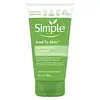What's inside
What's inside
 Key Ingredients
Key Ingredients

 Benefits
Benefits

 Concerns
Concerns

 Ingredients Side-by-side
Ingredients Side-by-side

Water
Skin ConditioningDecyl Glucoside
CleansingAloe Barbadensis Leaf Juice
Skin ConditioningGlycerin
HumectantXanthan Gum
EmulsifyingSodium Citrate
BufferingTriticum Vulgare Germ Oil
EmollientCitric Acid
BufferingCitrus Aurantium Dulcis Peel Extract
Emulsion StabilisingBenzyl Alcohol
PerfumingBenzoic Acid
MaskingDehydroacetic Acid
PreservativeTocopherol
AntioxidantLavandula Angustifolia Oil
MaskingCitrus Aurantium Amara Flower Oil
MaskingLinalool
PerfumingAverrhoa Carambola Fruit Extract
Skin ConditioningPachyrhizus Erosus Root Extract
Skin ConditioningCananga Odorata Flower Oil
MaskingWater, Decyl Glucoside, Aloe Barbadensis Leaf Juice, Glycerin, Xanthan Gum, Sodium Citrate, Triticum Vulgare Germ Oil, Citric Acid, Citrus Aurantium Dulcis Peel Extract, Benzyl Alcohol, Benzoic Acid, Dehydroacetic Acid, Tocopherol, Lavandula Angustifolia Oil, Citrus Aurantium Amara Flower Oil, Linalool, Averrhoa Carambola Fruit Extract, Pachyrhizus Erosus Root Extract, Cananga Odorata Flower Oil
Water
Skin ConditioningSodium Cocoyl Alaninate
Cocamidopropyl Hydroxysultaine
CleansingDecyl Glucoside
CleansingGlycerin
HumectantPropanediol
SolventGlycol Distearate
EmollientAcrylates/C10-30 Alkyl Acrylate Crosspolymer
Emulsion StabilisingSodium Benzoate
MaskingCocamidopropyl Betaine
CleansingLaureth-4
EmulsifyingCapryloyl Glycine
CleansingUndecylenoyl Glycine
CleansingPanthenol
Skin ConditioningPolyquaternium-39
Tocopheryl Acetate
AntioxidantWater, Sodium Cocoyl Alaninate, Cocamidopropyl Hydroxysultaine, Decyl Glucoside, Glycerin, Propanediol, Glycol Distearate, Acrylates/C10-30 Alkyl Acrylate Crosspolymer, Sodium Benzoate, Cocamidopropyl Betaine, Laureth-4, Capryloyl Glycine, Undecylenoyl Glycine, Panthenol, Polyquaternium-39, Tocopheryl Acetate
Ingredients Explained
These ingredients are found in both products.
Ingredients higher up in an ingredient list are typically present in a larger amount.
Decyl Glucoside is a glucose-based surfactant and emulsion stabilizer. It is created by reacting glucose with the fatty acids from plants.
Surfactants help clean the skin by trapping oil, sebum, and dirt to be washed away. As an emulsion stabilizer, it stabilizes the ingredients in a product by preventing them from separating.
This ingredient is biodegradable and non-toxic. This ingredient is commonly found in baby shampoos.
Decyl Glucoside is sometimes used to stabilize the UV filter Tinosorb.
Learn more about Decyl GlucosideGlycerin is already naturally found in your skin. It helps moisturize and protect your skin.
A study from 2016 found glycerin to be more effective as a humectant than AHAs and hyaluronic acid.
As a humectant, it helps the skin stay hydrated by pulling moisture to your skin. The low molecular weight of glycerin allows it to pull moisture into the deeper layers of your skin.
Hydrated skin improves your skin barrier; Your skin barrier helps protect against irritants and bacteria.
Glycerin has also been found to have antimicrobial and antiviral properties. Due to these properties, glycerin is often used in wound and burn treatments.
In cosmetics, glycerin is usually derived from plants such as soybean or palm. However, it can also be sourced from animals, such as tallow or animal fat.
This ingredient is organic, colorless, odorless, and non-toxic.
Glycerin is the name for this ingredient in American English. British English uses Glycerol/Glycerine.
Learn more about GlycerinWater. It's the most common cosmetic ingredient of all. You'll usually see it at the top of ingredient lists, meaning that it makes up the largest part of the product.
So why is it so popular? Water most often acts as a solvent - this means that it helps dissolve other ingredients into the formulation.
You'll also recognize water as that liquid we all need to stay alive. If you see this, drink a glass of water. Stay hydrated!
Learn more about Water